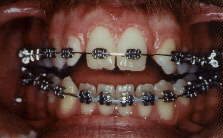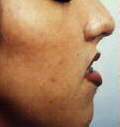What is orthognathic surgery?
The word orthognathic comes from the root words "ortho" meaning correct or straight and "gnathos" meaning jaw and those two words actually describe quite well the function of orthognathic surgery. This type of surgery is intended to correct skeletal mismatches. That is, when one jaw is too large, too small, too far forward or too far back in relation to the cranial base (the bones which house and protect the brain). It is not intended to replace orthodontics (braces) which can straighten the teeth out over the existing bone but cannot change the bony relationships however, orthodontics are often needed both before and after orthognathic surgery in order to give the patient the best possible result.

This condition is called apertognathia or open bite and can often be corrected by changing the angle at which the whole upper jaw is attached to the facial skeleton. The name of this surgical procedure is Le Fort I osteotomy.
Perhaps you have seen or know someone who can close their back teeth together and yet a space remains open between their front teeth. These people lose the ability to incise their food. They are unable to bite effectively into a sandwich and pizza becomes a food that must be consumed with a fork and knife.



Or perhaps you know someone with a prognathic mandible, popularly called "an underbite". The problem may be a mandible (lower jaw) which has grown too large or too far forward. Alternatively, the same problem can be caused by a maxilla (upper jaw) which has failed to develop enough. Depending on the cause, this condition may be corrected by surgery in the lower jaw ("sagittal split" or "intraoral vertical ramus osteotomy") or surgery in the upper jaw ("Le Fort I") or both. A discussion of the factors that determine which surgery will be performed is outside of the scope of this presentation.


Or perhaps you have met someone whose smile is just "too gummy". Now often, particularly in women, showing a bit of gingiva (gums) can be quite attractive but there are times when it is not attractive and it is an
indication of a maxilla that has grown too far down. The name of the condition is Vertical Maxillary Excess
and the surgical correction is via Le Fort I osteotomy and maxillary intrusion; all fancy ways to say, you move the upper jaw upwards.
Probably the most common problem for which orthognathic surgery is performed in the United
States is retrognathia, more commonly (though not always correctly) referred to as "overbite". If you look carefully at the pictures above you may note that in addition to the vertical maxillary excess discussed this
patient also had a mandible that was too far back, thus a combination of orthodontics (braces) and orthognathic surgery (Le Fort I and sagittal split with advancement) were utilized to correct the skeletal disharmonies.
We have only begun to touch on the array of diagnoses and procedures which fall under the category of orthognathic surgery. Hopefully, this will give you a starting point for further discussion of your case with your doctors.


Copyright Kim E. Goldman, D.M.D. 1995, 1996, 1997, 1998, 1999, 2000, 2001, 2002, 2003, 2004, 2005
Visitors since counter was last reset!